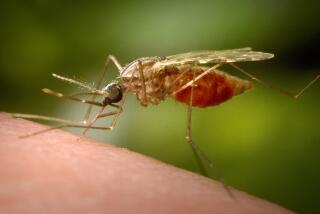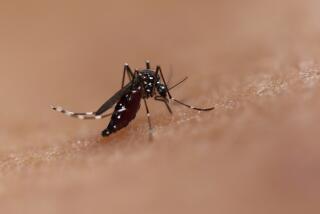Mosquito subspecies presents challenge in fighting malaria
Researchers have discovered a previously unknown subspecies of mosquito in West Africa that is highly susceptible to the malaria parasite and whose existence may stymie efforts to eradicate the deadly disease.
Unlike the indoor-dwelling mosquitoes that are the usual targets of malaria eradication efforts, members of the newly described subgroup of the species Anopheles gambiae live outdoors, which means they’re more difficult to kill, according to the study published online Thursday in the journal Science.
“We’ve got egg on our face,” said William Black, a medical entomologist at Colorado State University who was not involved in the study. “We’ve been working with this mosquito for so long … and right under our noses, here’s this other form of mosquito,” he said — one that could force researchers “to start thinking about what’s going on outside of those huts.”
Malaria is an incurable blood disease caused by parasites in the genus Plasmodium. Mosquitoes spread the parasite by drawing blood from infected humans, becoming carriers themselves and then transmitting the parasite to other humans they bite.
Malaria victims suffer headaches, high fever, chills, vomiting, anemia and sometimes death. There are about 250 million cases and nearly 1 million deaths each year, according to the World Health Organization.
Anopheles gambiae is thought to be the most significant malaria transmitter in Africa, and it has resisted repeated efforts to wipe it out, said Kenneth Vernick, a vector geneticist at the Pasteur Institute in Paris who co-wrote the study. Malaria control projects going back to the 1970s have apparently failed because they used tactics such as indoor sprays and chemically treated bed netting that only targeted mosquitoes inside human homes.
One of the reasons for focusing on indoor insects “is that people imagine that mosquitoes that are in proximity to people might be the most epidemiologically important to transmit malaria,” Vernick said. But there’s another, less scientific reason as well, he added: “Because it’s easy.”
Outdoor mosquitoes, on the other hand, are notoriously difficult to kill, let alone capture to study in experiments. Without the benefit of walls and a roof, Vernick said, “you don’t have a defined space to spray-bomb and catch them and have them fall on a sheet.”
Instead of chasing after the adult insects, the researchers decided to search for them in the larval stage, when they’re easier to capture. Mosquitoes breed close to human habitations in puddles of standing water that collects in tire-tracks or hoof prints, for example. In West Africa, standing bodies of water are hard to come by, so all types of mosquitoes would likely be forced to use common puddles to hatch their young.
The researchers traveled across Burkina Faso, collecting larvae from puddles around villages and growing thousands of mosquitoes over a four-year period. They genetically analyzed the young and found that only 43% of the larvae in the puddles were the indoor variety — meaning that 57% were not.
When the researchers fed the mosquitoes blood from humans who had malaria, 58% of the outdoor mosquitoes became infected with the parasite, compared with 35% of the indoor-resting ones.
Now scientists need to capture adult outdoor mosquitoes and study their feeding habits so they can determine whether the insects are a significant malaria threat, Black said. If so, he concluded, “it means we’re going to have to change a lot of our control tactics.”
More to Read
Sign up for Essential California
The most important California stories and recommendations in your inbox every morning.
You may occasionally receive promotional content from the Los Angeles Times.











